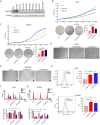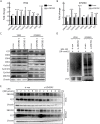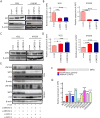ZNF292 suppresses proliferation of ESCC cells through ZNF292/SKP2/P27 signaling axis
- PMID: 35125808
- PMCID: PMC8742179
- DOI: 10.21147/j.issn.1000-9604.2021.06.01
ZNF292 suppresses proliferation of ESCC cells through ZNF292/SKP2/P27 signaling axis
Abstract
Objective: Increasing evidence has demonstrated that ZNF292 plays a suppressive role in cancer, however, little is known about its function and exact mechanism in esophageal squamous cell carcinoma (ESCC).
Methods: Bioinformatic analysis and immunohistochemistry (IHC) were performed to analyze the role of ZNF292 in affecting the prognosis of ESCC. Cell proliferation and colony formation ability assays were performed to analyze cell growth after inferring the expression of ZNF292. Flow cytometry was used to analyze changes in the cell cycle upon the depletion of ZNF292. Quantitative real-time polymerase chain reaction (qRT-PCR) and western blot analysis were used to determine the alteration of cell cycle related RNAs and proteins after knocking down ZNF292. MG-132, cycloheximide (CHX) treatment experiments were performed to analyze the change and half-life time of P27 after knockdown of ZNF292. Chromatin immunoprecipitation (ChIP) and luciferase reporter assays were used to analyze the transcriptional regulation of SKP2 by ZNF292.
Results: We report that low expression of ZNF292 is associated with poor prognosis, and ZNF292 emerges to be highly expressed in adjacent and normal tissues rather than tumor tissues in ESCC. Knockdown of ZNF292 significantly boosts cell growth and S phase entry in ESCC cells. ZNF292 depletion will decrease the expression and half-life time of P27, while knockdown of SKP2 will result in elevated expression of P27. ZNF292 can bind to the promoter region of SKP2, and knockdown of ZNF292 will boost the expression of SKP2.
Conclusions: Knockdown of ZNF292 mediates G1/S cell cycle procession by activating SKP2/P27 signaling in ESCC cells. ZNF292 knockdown promotes SKP2 expression at the transcriptional level, thereby boosting P27 ubiquitin-degradation, and eventually facilitating the S phase entrance.
Keywords: ESCC; SKP2; ZNF292; cell cycle.
Copyright ©2021Chinese Journal of Cancer Research. All rights reserved.
Conflict of interest statement
Conflicts of Interest: The authors have no conflicts of interest to declare.
Figures






References
LinkOut - more resources
Full Text Sources
Miscellaneous
